Self-Duet Videos in REAPER
I’ve shot a few self-duet vidoes over the last few years, playing both sides using different tunings or instruments or just having a lead with accompaniment. It took me a few years to figure out the tricks that make this kind of video work, but with some careful staging and framing of the shoot and a powerful NLE (Non-linear Editor) for the editing the process is actually pretty simple.
I’ve gotten requests to do a tutorial on self-duets, and happily REAPER video features have advanced enough to make self-duet edits a snap, so I set up in the living room and played through my old favorite, Salomila, on the slack key guitar with `ukulele accompaniment. And I did a tutorial video as I went through the process of editing a self-duet video in REAPER.
Staging and Framing
The first trick to creating a self-duet is the staging. We need a space wide to have both players side by side and deep enough so the camera captures both sides at the same time. Framing the whole stage and locking the camera in position as each side of the duet plays their part makes it a snap to line up the video in the edit.
The depth required depends on the camera lens, a wide angle lens lets the camera get closer but it can lead to visual distortion if you get too close. The iPhone 6+ I used has about a 30mm lens (in FF equivalent) so the camera was positioned about 7 feet from the players in order to capture both.
Here’s what my stage looked like for this clip. You can see the iPhone 6+ I’m using for the video mounted on a dining room chair with a GorillaPod support system.
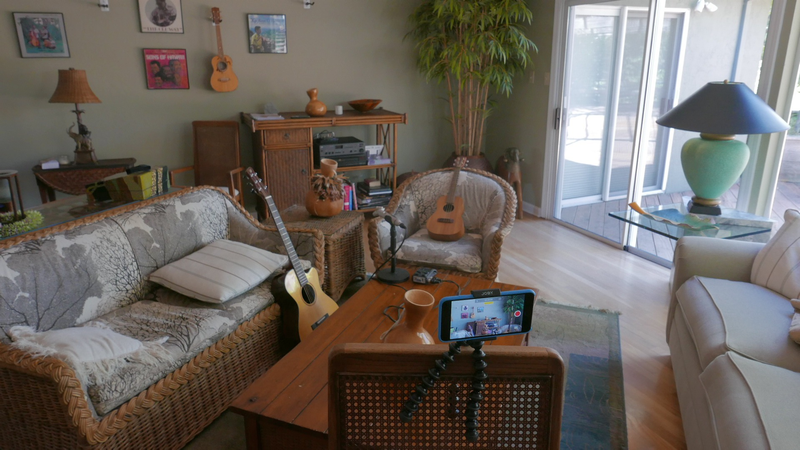
Besides stage width, it’s handy to have reference markers in or near the center of the shot and at the outer edges of the camera frame. In this layout, the ipo or Hawaiian gourd drum marks the middle of the shot, and I made sure I positioned myself and the instruments so each side of the duet stayed on their side of the centerline.
Here’s how it looked to the camera.
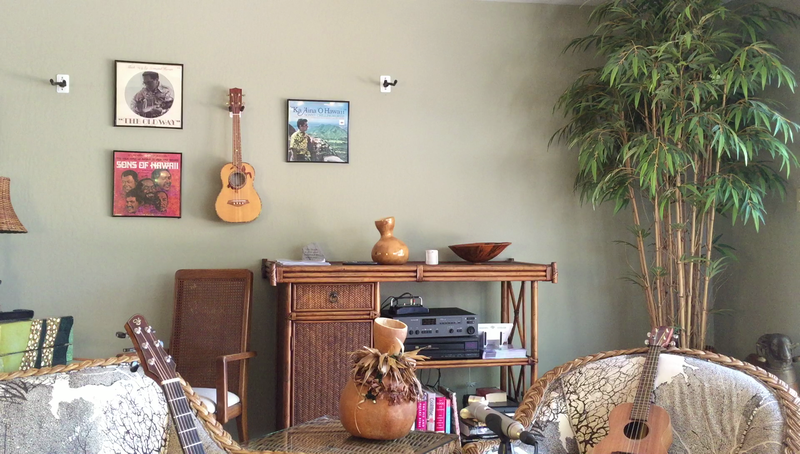
I’m using the back cushion of the wicker loveseat and the right edge of the chair as outer markers, with the Hawaiian ipu (gourd drum) as my center marker. Here’s a look at the first side of the duet, the guitar player on the left:
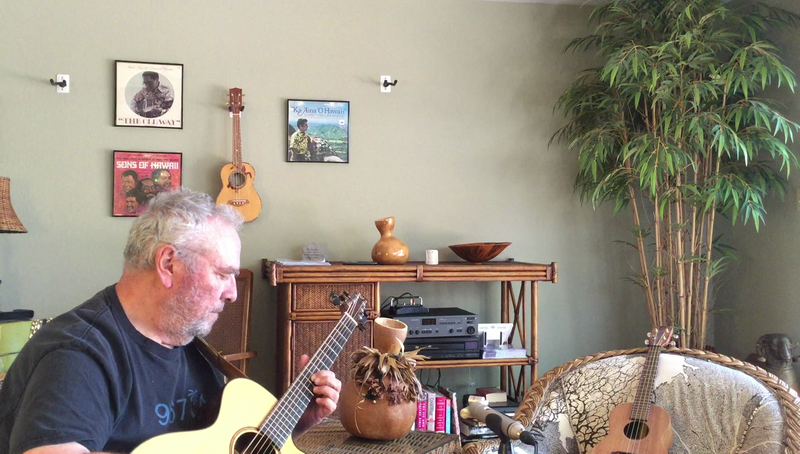
You can see how things line up on either side of the centerline with this shot of the second side, the `ukulele player on the right:
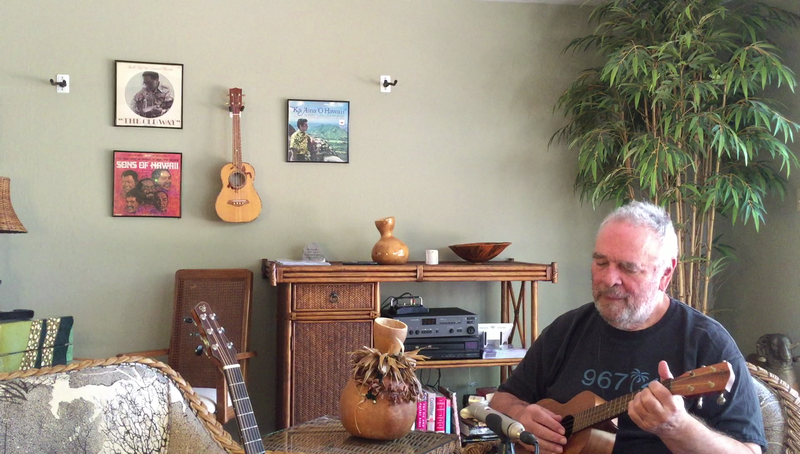
Another critical aspect of the staging is the lighting. If the light varies during the shoot it will probably spoil the duet effect since the two sides will not match. It’s sometimes possible to tweak the exposure a bit in a high powered NLE, but so far I haven’t had success when trying to correct for shifting light with the tools in REAPER (version 5.16).
Capture
I usually use a click track for these videos, and I always listen to the first part when I’m playing the second, just as if I were overdubbing in a recording session. Trying to use camera audio for these self-duet videos hasn’t worked for me because no camera I’ve used offered the click track or overdubbing. I’m sure someone can come up with a workaround but for my sessions I’ve always used a parallel recording system with the camera audio serving only as a guide for syncing.
I’ve used REAPER to record the audio for some of my past clips, and it does a great job. And recording and overdubbing audio in REAPER means that the audio tracks are lined up automatically, saving some steps in the edit. On the other hand using REAPER means staying in my home studio instead of using other locations. So after a little fiddling I figured out the very limited overdubbing on the Zoom H6 and I’ve used it for self-duets as I did in the sample clip here. Note that on the Zoom H6 it’s not possible to overdub using just the XY module for both passes. Each new overdub recording must use a different input. This is not a problem if I’m recording both instruments using pickups and going direct in but for acoustic recording I have to use an external mic.
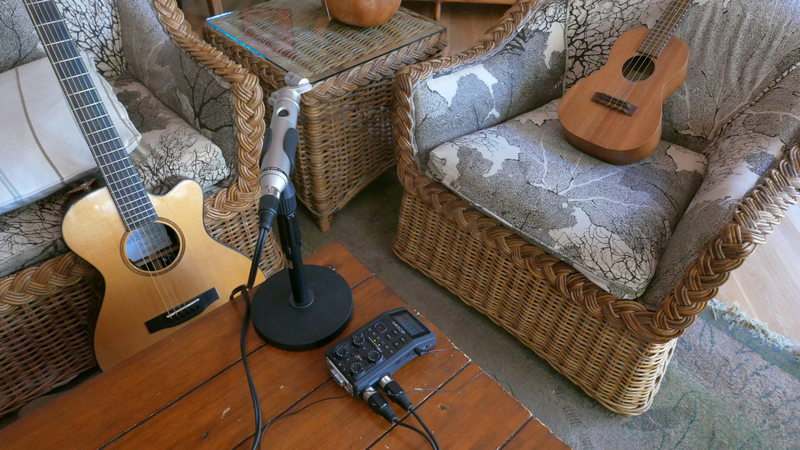
In this sample session I used a Rode NT4 stereo mic, but I actually only recorded one channel for each instrument. In some past self-duets I’ve recorded both sides in stereo, and was pleased with the result, but using mono tracks and panning them works just as well and perhaps reduces the ambient noise capture.
As far as video goes, the needs are simple: a camera that offers a wide enough angle to fit the space and allows locking of the focus and exposure, and a solid support for the camera. If the camera starts automatically changing focus or exposure the chances are it will spoil the duet effect. And keeping the camera in the same position throughout the duet is the real key to making the edit quick and easy.
Finally, I definitely find the HD format better than SD for these videos, just because of the wider frame.
Editing
There are a just a couple of features a video editing program must have in order for us to assemble these self-duet videos. First it must support multiple video and audio tracks with free positioning, then it must allow us to crop away part of one track to make another track visible while both are playing. With the video processor added to REAPER in version 5 we have the tools we need.
In the demo video you can watch the editing process, but the basics are very simple. In this example we have three tracks – one for video and two for audio. We have only one video track because I left the camera running as I switched sides of the duet. So our edit consists of separating the video into two tracks, aligning the audio tracks with their respective video, then aligning the two pairs of video and audio so the performers are playing together. Then we use the REAPER Video Processor set to its “horizontal wipe” preset to crop the empty chair away and expose the second half of the duet.
There’s just one more detail, and that’s the order of the video tracks. By default REAPER displays the video track with the highest track number, the bottom of the list of tracks. You can change the order in a Project Settings. Since the horizontal wipe occurs from right to left, it will crop the right side of our clip, so the clip with the player on the left needs to be the default visible track. Then when the horizontal wipe crops the picture, the player on the right will show through from the next track.
Sample and Tutorial
Here’s the result of our self-duet session, a single chorus of old favorite “Salomila” played in taropatch open G tuning on the Tony Yamamoto OM-Y guitar and low G C6 tuning on the Ko`olau tenor `ukulele. Not the sharpest performance ever and not framed perfectly, but it gets the idea across I hope.
And this clip takes you through the editing process, so you can see the steps to make your own self-duet videos.
There are plenty of additional things to try when using this technique. With the right space you can have more than two players, a self-trio or self-quartet, for instance. The stage needs to be wide and you need room to position the camera, but after that the basics are the same. Costuming can add to the fun, I often change shirts or hats when I change sides in the duet. A second camera can be used for closeups, just frame the first player in close, making sure not to show the other side of the stage. Then reposition this closeup camera for the second performer. It adds to the syncing and editing process but having these closeup shots adds visual interest in a full length song.
This entry was posted on Tuesday, October 4th, 2016 at 3:57 pm and is filed under Tutorials, Video. You can follow any responses to this entry through the RSS 2.0 feed. You can leave a response, or trackback from your own site.
David said in post # 1,
on January 9th, 2017 at 8:32 pm
This looks like so much fun. I’ll try out. I’m good with sound and mixing, but just now trying to get into video too. Also, you’re the most adorable man. Your smiles each time you finish a take are priceless.
What kind of tree is it in the background?
Fran Guidry said in post # 2,
on January 9th, 2017 at 9:19 pm
Thank you David for your very kind comments. The tree in the background is an artificial bamboo.
Fran